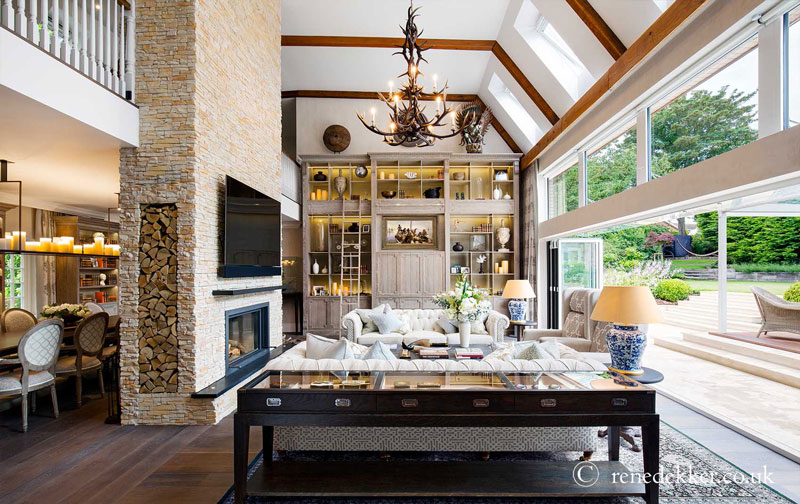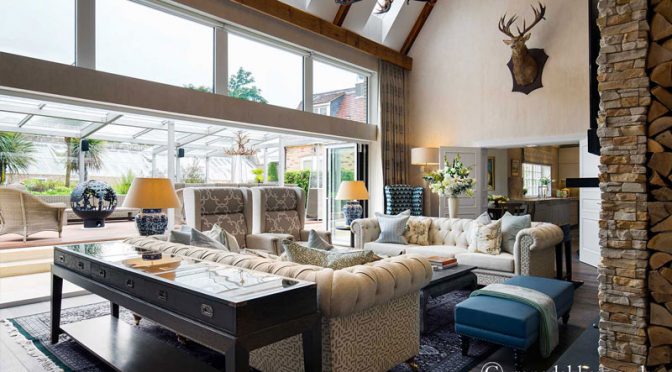Think of an English country home, and images of rose-covered, beamed cottages usually spring to mind. Some of these might sport a thatched roof; others will have twisting chimneys dating back to Tudor times, and tease the visitor with the promise of secret rooms and a history waiting to be discovered. Dark interiors are filled with an eclectic mix of furnishings, while elements of the surrounding bloom-filled garden creep inside through the floral motifs on the curtain fabrics and cushions.
Alternatively, you might think of a Georgian manor or Downtown Abbey, with elegant proportions and large fireplaces to warm the substantial spaces. High-ceilinged, light-filled rooms in these properties are often punctuated with window seats that would please the cast of a Jane Austen novel.
Then there’s the farmhouse with its barn doors and an abundance of pine, particularly in the kitchen which is very much the heart of the home, often with an Aga pumping heat at all times of the year. Tiles protect the floors from the onslaught of muddy boots and puppy paws, while faded rugs and wood-burning stoves create a cosy, relaxed feel.
Finally, there is the baronial look as seen in castles or hunting lodges. Many have castellations or lookout posts, the overall theme being one of protection and defence. Very much the realm of the testosterone-fuelled hunting, fishing and shooting brigade, interiors for these properties often include trophies of varying degrees of animal slaughter, suits of armour, military relics and tapestries. The colours tend to be dark and muted, creating a sombre, grander feel, echoing the social standing of the property’s owner.
Either way, the look and feel of an authentic English country home usually takes years to achieve. It involves a gradual selection of the very best furnishings and art collected over the decades and careful curation of souvenirs and photographs amassed over generations. With the luxury of time, the overall effect is one of rural ease, an ageless, comfortable classic filled with history, tradition and individuality. The one thing an English country home is not – is minimalist!

Today, however, recreating this look is achievable without the element of time to allow a scheme to develop and evolve, and a top interior designer will be able to achieve this. An interiors expert will also be able to add contemporary touches that seamlessly blend into the overall look without any jarring, or with the scheme looking too “themed.”
Although technology is not at the forefront of a country scheme, there are ways to incorporate modern elements without compromising on the style. Sound systems can be integrated or hidden behind units, while televisions can be disguised as paintings above a fireplace.
Colours range from pretty pastels in shades of pink and yellow, to deeper, more traditional rural hues of Claret and Forest Green, while punches of Cobalt Blue teamed with cream create a feeling of freshness. It’s possible to mix and match these hues within the same property, providing there is a sense of continuity. This can be achieved by using a consistent theme such as the same tone of colour or motif, for example a floral or botanical design.

Using this pattern on a bigger scale, such as a mural or a large canvas can also provide a more contemporary feel, thereby bridging the gap between traditional and modern, while still being loyal to the country origins.
In the hands of a luxury interior designer, a country look can indeed be recreated to combine the best of both worlds – the conveniences and freshness of the modern world in which we live today together with a timeless feel of relaxed comfort.
The author PG Woodhouse sums it up nicely: “The cup of tea on arrival at a country house is a thing which, as a rule, I particularly enjoy. I like the crackling logs, the shaded lights, the scent of buttered toast, the general atmosphere of leisured cosiness.”
